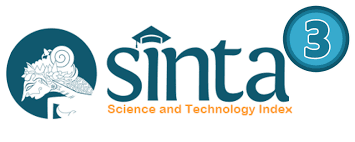Identification Of Diseases In Rice Plant Using Chatbot With Methode Artificial Intelligence Markup Language and Normalization
Abstract
Keywords
Full Text:
PDFReferences
M. Jain, R. Kota, P. Kumar, and S. N. Patel, “Convey: Exploring the Use of a Context View for Chatbots,” Proceedings of the 2018 CHI Conference on Human Factors in Computing Systems, pp. 1–6, Apr. 2018.
F. B. Putra et al., “Identification of Symptoms Based on Natural Language Processing (NLP) for Disease Diagnosis Based on International Classification of Diseases and Related Health,” 2019 International Electronics Symposium (IES), pp. 1–5, 2019.
P. N. Crisnapati, P. D. Novayanti, G. Indrawan, K. Y. E. Aryanto, and M. S. Wibawa, “Accuracy Analysis of Pasang Aksara Bot using Finite State Automata Transliteration Method,” 2018 6th International Conference on Cyber and IT Service Management (CITSM), pp. 1–6, 2018.
D. Christianto, E. Siswanto, and R. Chaniago, “Penggunaan named entity recognition dan artificial intelligence markup language untuk penerapan chatbot berbasis teks,” Jurnal Telematika, vol. 10, no. 2, p. 8, 2016.
C. Virmani, A. Pillai, and D. Juneja, “Extracting Information from Social Network using NLP,” 2017.
I. Arimbawaa, … N. Er.-E. I. K. U. p, and undefined 2017, “Lemmatization in Balinese Language,” ojs.unud.ac.id.
S. Das and E. Kumar, “Determining accuracy of chatbot by applying algorithm design and defined process,” 2018 4th International Conference on Computing Communication and Automation (ICCCA), pp. 1–6, 2018.
Q. N. Nguyen and A. Sidorova, “Understanding User Interactions with a Chatbot Understanding User Interactions with a Chatbot: A Self-determination Theory Approach Emergent Research Forum (ERF),” 2018.
Kasey Panetta, “Gartner Top Technologies for Security in 2017 - Smarter With Gartner,” 05-Jul-2017. [Online]. Available: https://www.gartner.com/smarterwithgartner/gartner-top-technologies-for-security-in-2017/. [Accessed: 26-Mar-2020].
J. Pereira and O. Díaz, “A quality analysis of facebook messenger’s most popular chatbots,” in Proceedings of the ACM Symposium on Applied Computing, 2018, pp. 2144–2150.
L. K. Fryer, M. Ainley, A. Thompson, A. Gibson, and Z. Sherlock, “Stimulating and sustaining interest in a language course: An experimental comparison of Chatbot and Human task partners,” Computers in Human Behavior, vol. 75, pp. 461–468, 2017.
H. Shah, K. Warwick, J. Vallverdú, and D. Wu, “Can Machines Talk? Comparison of Eliza with Modern Dialogue Systems,” Computers in Human Behavior, vol. 58, pp. 278–295, May 2016.
L. K. Fryer, M. Ainley, and A. Thompson, “Modelling the links between students’ interest in a domain, the tasks they experience and their interest in a course: Isn’t interest what university is all about?,” Learning and Individual Differences, vol. 50, pp. 157–165, 2016.
M. F. H. Husein, U. Darusalam, and A. Aningsih, “Application of the O-Chat Bot Program to Provide Learning Motivation to National University Students Using AIML,” 2020.
F. Azwary, F. Indriani, and D. T. Nugrahadi., “Question Answering System Berbasis Artificial Intelligence Markup Language sebagai Media Informasi,” Klik-Kumpulan Jurnal Ilmu Komputer, vol. 3, no. 1, pp. 48–60, 2016.
L. K. Fryer and K. Nakao, “Chatbot learning partners: Connecting learning experiences, interest and competence,” Computers in Human Behavior, 2019.
A. Santokhee, G. Bekaroo, N. Teckchandani1, A. Santokhee1, and G. Bekaroo1, “AIML and Sequence-to-Sequence Models to Build Artificial Intelligence Chatbots: Insights from a Comparative Analysis Chapter 30 AIML and Sequence-to-Sequence Models to Build Artificial Intelligence Chatbots: Insights from a Comparative Analysis,” Springer, vol. 561, pp. 323–333, 2019.
Article Metrics
Abstract has been read : 1150 timesPDF file viewed/downloaded: 0 times
DOI: http://doi.org/10.25273/research.v3i2.7060
Refbacks
- There are currently no refbacks.

This work by Research is licensed under a Creative Commons Attribution-NonCommercial-ShareAlike 4.0 International License.








